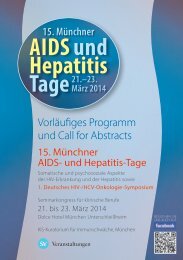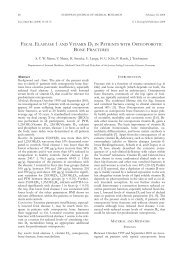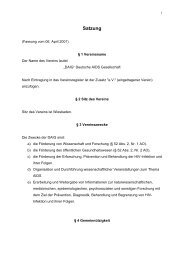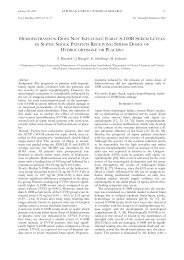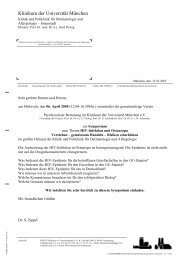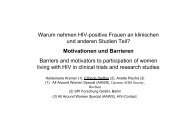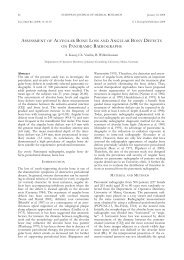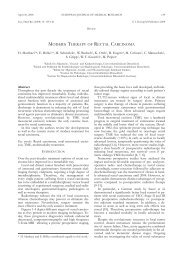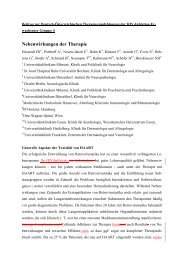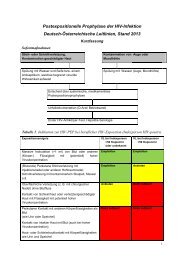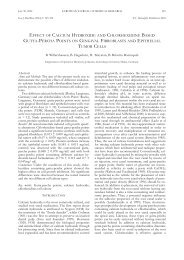European Journal of Medical Research - Deutsche AIDS ...
European Journal of Medical Research - Deutsche AIDS ...
European Journal of Medical Research - Deutsche AIDS ...
Create successful ePaper yourself
Turn your PDF publications into a flip-book with our unique Google optimized e-Paper software.
June 27, 2007 EUROPEAN JOURNAL OF MEDICAL RESEARCH<br />
109<br />
D.75 (Poster)<br />
12h pharmacokinetic assessments <strong>of</strong> ART plasma<br />
concentrations in a cohort <strong>of</strong> HIV-positive<br />
pediatric patients<br />
Königs C. 1 , von Hentig N. 2 , Scheuplein M. 1 ,<br />
Beuckmann K. 1 , Kurowski M. 3 , Funk M. 4 , Linde R. 1 ,<br />
Kreuz W. 1<br />
1 JW Goethe University, Department for Pediatrics, Hemostasis<br />
and Immundeficiency Treatment and <strong>Research</strong> Unit, Frankfurt,<br />
Germany, 2 JW Goethe University, Department for Pharmacology,<br />
Frankfurt, Germany, 3 HIV Lab, Berlin, Germany,<br />
4 Paul-Ehrlich-Institut, Langen, Germany<br />
Therapeutic drug monitoring (TDM) is getting more and more<br />
common in modern antiretroviral therapy (ART). In pediatric<br />
patients, ART is <strong>of</strong>ten started in the first twelve months <strong>of</strong> life<br />
and probably a life-long therapy is needed. Very limited information<br />
on plasma concentration <strong>of</strong> antiretroviral substances in<br />
children is available. Early pharmacokinetic (PK) data from pediatric<br />
cohorts suggests the need for TDM in this population.<br />
In the Frankfurt pediatric cohort more than 60 pharmacokinetic<br />
analyses have been performed over a full dosing interval<br />
(i.e. 12 or 24 hrs). Patients were monitored following a standard<br />
protocol. PKs were performed after initiation <strong>of</strong> ART or<br />
change <strong>of</strong> regiment. Parents or patients documented ART intake<br />
three days prior to PK. On the PK day, blood was drawn in<br />
a fasting state, children had breakfast and took their medication<br />
according to recommendations in the out-patient unit. Serum<br />
samples were drawn at 1, 2, 3, 4, 6, 8 and12 hrs after intake (for<br />
once daily regiments also 24hrs). Additionally plasma concentrations<br />
<strong>of</strong> single time points were taken when patients had routine<br />
checks at the out-patient unit. All protease inhibitors and<br />
non-nucleoside reverse transcriptase inhibitors were examined.<br />
Results showed a great inter patient variability in plasma<br />
Cmin, Cmax and AUC for all antiretroviral substances tested.<br />
Most pediatric patients – especially very young children – had<br />
plasma levels below the range observed in an adult population.<br />
Only some <strong>of</strong> the patients, who were ten years and older,<br />
reached levels close to those seen in the adult populations.<br />
Some extremely high plasma concentrations were seen for<br />
some substances including EFV and LPV/r and correlated<br />
with side effects.<br />
In conclusion, TDM in a pediatric cohort under ART shows<br />
very different results to those seen in adults. Most observed plasma<br />
concentrations are much lower than in the adult population.<br />
Studies are needed to monitor plasma levels <strong>of</strong> antiretroviral drugs<br />
in children and to correlate the findings with clinical outcome.<br />
D.76 (Poster)<br />
Ritonavir (RTV) als häufigster<br />
Kombinationspartner der ART – Bedeutung des<br />
Therapeutischen Drug Monitorings (TDM) für<br />
eine individualisierte Therapie<br />
Bemman R. 1 , Threin A. 2 , Schirmer D. 1 , Leyh M. 1 ,<br />
Winzer R. 1 , Heinz W. 1 , Guhl C. 1 , Schnaitmann E. 2 ,<br />
Klinker H. 1 , Langmann P. 3<br />
1 Medizinische Klinik und Poliklinik II der Universität<br />
Würzburg, Schwerpunkt Infekiologie, Würzburg, Germany,<br />
2 Schwerpunktpraxis, Schwabstr. 57-59, Stuttgart, Germany,<br />
3 Praxis für Gastroenterologie und Infektiologie, Karlstadt,<br />
Germany<br />
Hintergrund: RTV wird bei allen PI-basierten Therapien in<br />
einer Dosis von 100–200mg/d als „boost“ eingesetzt. Durch<br />
Hemmung des CYP-Systems ergibt die Kombination mit<br />
RTV jedoch häufig eine Vielzahl von Interaktionen innerhalb<br />
der ART und anderer Begleitmedikamente.<br />
Fragestellung: Anhand der Auswertung der RTV-Plasmaspiegel<br />
an einem größeren Patientenkollektiv sollte der<br />
Einfluss einer nicht-antiretroviralen Begleitmedikation, der<br />
Einfluss einer chronischen Lebererkrankung, das Auftreten<br />
von Nebenwirkungen, sowie die Varianz der RTV-Konzentrationen<br />
in unterschiedlichen PI-Kombinationen untersucht<br />
werden.<br />
Methodik: Von 321 Patienten wurden insgesamt 341 RTV-<br />
Plasmaspiegel mittels HPLC mit UV-Detektion gemessen.<br />
Die retrospektive Auswertung wurde anhand der Angaben auf<br />
dem Einsendebogen durchgeführt. Zur statistischen Analyse<br />
wurde der Mann Whitney Test herangezogen.<br />
Ergebnisse: Die RTV Plasmaspiegel nach einer Dosis von<br />
0,1-0,6g/d lagen in Abhängigkeit vom Zeitintervall der<br />
Spiegelmessung nach der Medikamenten-einnahme bei<br />
111ng/ml bis 6880ng/ml. Bei 3% der Patienten wurden 1 bis 4<br />
Begleitmedikamente verabreicht. Bei Patienten mit einem<br />
Therapieversagen (n=40) waren die RTV-Plasmaspiegel mit<br />
865±1156ng/ml nicht niedriger als bei den Patienten mit<br />
einem Therapieansprechen. Bei n=39 Patienten mit einer<br />
chronischen Lebererkrankung zeigten die RTV-Spiegel mit<br />
946±1268ng/ml eine etwas größere Schwankungsbreite als<br />
bei Patienten ohne eine begleitende Lebererkrankung. Bei<br />
Vorliegen von Nebenwirkungen waren die RTV-Spiegel<br />
(489±415ng/ml) nicht erhöht. In der Kombination mit anderen<br />
PI waren RTV-Plasmaspiegel in der Kombination mit IDV<br />
(n=66) von 1209±1224ng/ml, mit APV (n=37) von<br />
527±934ng/ml, mit ATV (n=72) von 383±395ng/ml und mit<br />
SQV (n=47) von 1551±2013ng/ml nachweisbar. Es zeigte<br />
sich eine deutliche Dosisabhängigkeit. Bei einer RTV Dosis<br />
von 0,1g/d lagen die RTV-Spiegel bei 111–688ng/ml,<br />
während die RTV-Talspiegel bei 0,2g/d im Bereich von<br />
98–1209ng/ml schwankten.<br />
Diskussion: Die RTV Plasmaspiegel zeigen eine große<br />
Schwankungsbreite. Dabei ist eine Abhängigkeit von der verabreichten<br />
Dosis nachweisbar. Im Rahmen der individualisierten<br />
Therapie ist bei Verwendung einer nicht „fixen“<br />
RTV-Kombination häufig unter TDM eine Anpassung der<br />
RTV-Dosierung möglich.<br />
D.77 (Poster)<br />
Safety <strong>of</strong> long-term Lopinavir plasma-levels in<br />
patients with liver dise<br />
Langmann P. 1 , Hubert C. 2 , Winzer R. 2 , Heinz W. 2 ,<br />
Guhl C. 2 , Threin A. 3 , Schnaitmann E. 3 , Klinker H. 2<br />
1 Praxis für Gastroenterologie und Infektiologie, Karlstadt,<br />
Germany, 2 Medizinische Klinik und Poliklinik II der<br />
Universität Würzburg, Schwerpunkt Infekiologie, Würzburg,<br />
Germany, 3 Schwerpunktpraxis, Schwabstr. 57-59, Stuttgart,<br />
Germany<br />
Objective: Chronic liver disease is <strong>of</strong>ten found in HIV infected<br />
patients. LPV as first choice protease inhibitor is <strong>of</strong>ten<br />
used over long time periods. Therapeutic Drug Monitoring<br />
(TDM) is an important tool in patient care but the knowledge<br />
<strong>of</strong> LPV-plasma-levels in patients with chronic liver disease<br />
remain uncertain. With this retrosepective analysis we investigated<br />
whether there are differences in LPV-plasma-levels between<br />
patients with and without chronic liver diseases over a<br />
long-time period.



